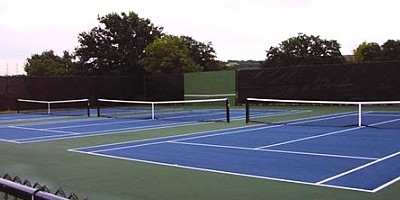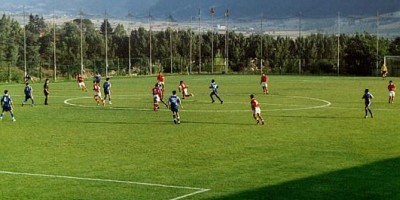Nanomaterial provides a large number of surface atomsfor the interaction with its environment. This is the basis of most nano-effects. Materials that are normally almost inactive increase their active surface by a factor of millions when used on the nano-scale.
The following estimation gives an impression of nanomaterial surface areas at the example of silver which is used in medical applications due to its antibacterial activity.  The American Silver Eagle, a silver bullion coin, has a surface area of 3,300 mm² (based on a diameter of 40.6 mm and a ridged edge of 3 mm). Our first consideration refers to a silver “nano-coating” that is sometimes sputtered onto components to make these anti-infective. When we use the material of one coin to generate a homogeneous 10 nm thin silver layer, this would be enough to coat an area of 770 square meters - which is almost three tennis courts (8,424 square feet).
The American Silver Eagle, a silver bullion coin, has a surface area of 3,300 mm² (based on a diameter of 40.6 mm and a ridged edge of 3 mm). Our first consideration refers to a silver “nano-coating” that is sometimes sputtered onto components to make these anti-infective. When we use the material of one coin to generate a homogeneous 10 nm thin silver layer, this would be enough to coat an area of 770 square meters - which is almost three tennis courts (8,424 square feet).
 The American Silver Eagle, a silver bullion coin, has a surface area of 3,300 mm² (based on a diameter of 40.6 mm and a ridged edge of 3 mm). Our first consideration refers to a silver “nano-coating” that is sometimes sputtered onto components to make these anti-infective. When we use the material of one coin to generate a homogeneous 10 nm thin silver layer, this would be enough to coat an area of 770 square meters - which is almost three tennis courts (8,424 square feet).
The American Silver Eagle, a silver bullion coin, has a surface area of 3,300 mm² (based on a diameter of 40.6 mm and a ridged edge of 3 mm). Our first consideration refers to a silver “nano-coating” that is sometimes sputtered onto components to make these anti-infective. When we use the material of one coin to generate a homogeneous 10 nm thin silver layer, this would be enough to coat an area of 770 square meters - which is almost three tennis courts (8,424 square feet).
Our second consideration refers to silver nanoparticles. If the material of one silver bullion coin was fragmented into spherical particles that are 10 nm in diameter, this would correspond to 5.66 billion billions of nanoparticles (5.66E18). The total surface area (the surface that can interact with the environment) would now measure more than 7,100 square meters (75,000 square feet). This is exactly the size of a soccer field of 7,140 m² (which is even larger than an American Football field of 5,350 m²).

In practice, this means that antibacterial applications require far less than the silver amount of one coin. Very small amounts of nanoparticles with a large surface activity are dispersed into fluids, applied to surfaces, or embedded into solid material. By embedding few micrograms of silver nanoparticles into a polymer, the slow emission of silver ions from the particle surfaces is enough to provide a material with antibacterial properties for months or even years.
The same principles apply to the surface activity of other types of nanomaterial: For example, small nanoparticles from platinum, palladium, or ruthenium can unfold hugecatalytic activity to flows of chemicals. Even the simple physical adjustment of viscosities of pastes and lotions is often realized by an addition of nanomaterial (nano-scaled powders like “Aerosil”) and is based on their strong surface interaction.
Fonte: Nanoparticles Blog
